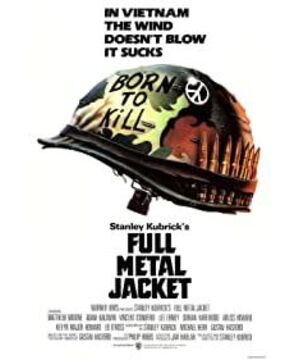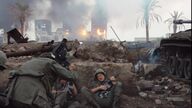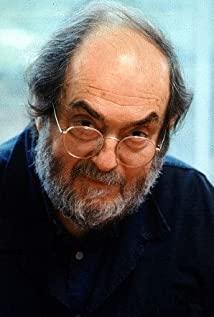Unlike any war in U.S. history, the Vietnam War was criticized from beginning to end, almost unanimously opposed from top to bottom. This inexplicable war made a high-profile appearance in a willful act, and then left the stage sadly amidst the scolding. This war not only had a huge impact on the political and economic situation of the United States, but also made a number of excellent works on the theme of the Vietnam War emerge in the American literary and art circles. "Full Metal Jacket" is one of them.
Taking time and space as the boundary, "Full Metal Jacket" can be divided into two parts: military camp training and Vietnam battlefield. The clown acts as the core character - both a witness and a participant, connecting these two parts in series. The theme of the film is very clear, that is, to express dissatisfaction with the Vietnam War in some kind of joke and ridicule, to show how human nature is going to be destroyed step by step in the alienation of the war, and it has evolved into a killing machine. Although the theme of this film is not ambiguous and the content is not obscure, it is still necessary to sigh Kubrick's grasp of the entire film, and his choice of shots and soundtracks are really exquisite and staggering.
In the 1960s and 1970s, the United States had a first-class navy that led the world's most powerful fleet, a second-class air force that kept the Japanese Nazis at bay, and a third-class army that was as powerful as John Rambo's propaganda. Our protagonist, however, is from the fourth-class Ma Run, known as the "tool man" - the Marine Corps, with low funding, high training intensity, and slow equipment renewal, and is often sent to the most dangerous battlefield.
The film kicked off with the brisk melody of "Hello, Vietnam", and a new group of newcomers was ushered in the boot camp. A series of short shots, all describing the same thing - a haircut. Blonde hair, black hair, brown hair, whatever color it is, get cut off. From now on, they will no longer be students, workers, white, black, or yellow, but will become soldiers of the Marine Corps, green soldiers, yellow soldiers, and camouflage soldiers. What follows is a one-minute, seventeen-second long shot of shaved recruits standing in line, receiving a highly insulting lecture from their superior in the dormitory. Comparing with the previous fragmentary short shots, it implies that they have moved from independent and free individuals to one of the collectives with blurred personality differences. Snowballs, clowns, cowboys... Nicknames have replaced names to identify individuals. With a name, you can only be you, without a name, you can be anyone. At that time they were still alive, happy and sad, laughing and angry, Reiner still smiling, and the clown knew how to mock.
Training, swearing, running, chorus, no one knows why they did it, no one knows why this war started, just someone told them to do it and they did it. "If I hang in the war zone, please go home with my ashes, hang a medal on my chest, and tell my mother that I did my best. Bury me under six feet until you fight until When we die, we will talk to each other when we reunite." This group of fourth-class Ma Run people sing the most fearless songs, sharpen their body and mind for the most dangerous things, and they are transforming into machines.
In the first half of the film, the change of Reiner's character is quite intriguing. The sluggishness, gluttony, and the iconic grin in the early stage, to the agility, indifference and even gloom in the later stage, this change seems to have begun to show after he was beaten by the crowd, and the Joker stood by and participated in it, but Kubrick obviously Smarter. The shots from 21:09 to 21:30 are not only beautiful in composition, but also metaphorical. The entire shot is taken as a still shot, and the arrangement of the clown, Reiner and the queue in the content of the picture forms an arrangement of close-up, medium-range, and long-range shots, and the sense of space in the picture is enhanced. At the same time, considering the beauty of the picture, the position of the clown's corner is always on the golden section line of the screen, and his line of sight is also on the golden section point. This is a very typical relationship shot, but when showing the relationship between the Joker, Reiner and the army, the director did not use a panoramic shot to explain the role relationship as we are familiar with, but let the three occupy three With different depths of field, the clown is in the front left, which is a close shot, Reiner is in the back right, which is a medium shot, and the army is behind the two, which is a long shot. Spatial distance also means distance between character relationships. The Joker helps Reiner keep up with training, and as the two get closer, they naturally distance themselves from others. When the clown spoke to Reiner, the army behind him just walked in the direction facing away from Reiner, implying that the act of the clown helping Reiner is a symbol of human nature, which is related to the purpose of the barracks - to train him to have a full metal shell. War Machine, is the opposite. Soon, Reiner learned how to fire a gun, and was finally able to keep up with the crowd, and the army behind him walked towards them. He took him and became them.
Because of the instructor's way of sitting together, the teammates resented Reiner, and agreed to beat him while he was sleeping to vent their anger. Reiner was beaten up in a dream, and seeing the clown who had shown kindness to him and helped him keep up with his training was also involved, the last trace of humanity in his heart was wiped out. He became a qualified tool man and never laughed again, except for the last moment before his suicide.
The soundtrack when Reiner shot the instructor and committed suicide is the same as the one used when the Viet Cong female sniper died, except that one is midnight, light blue tones, quiet, gloomy, and cold; the other is dusk, dark red tones, noisy , warm, heavy. These two pieces of soundtrack or a piece of soundtrack, the overall tone is low and depressed, using strings as the bass part of the overall music, no specific scale, no melody, only a sound similar to human breathing, low, stagnant, but not. It's like a living body, but it seems to come from some kind of machine, yes, "full metal shell", ready to come out.
The soundtrack first appeared on the night Reiner was mentally ill. The Joker is on duty and finds Reiner grinning on the toilet with his gun. This is the smile that Reiner leaked again after being beaten by the group. It was no longer a silly smile, but a savage smile, with a mockery about to be released and a curse waiting for you to become me. Heavy strings imitating human breathing, the Joker sees Reiner transformed into a "full metal shell" killing machine, the first person to kill is the instructor who taught him to become a tool, the second person to kill - and last A person is himself.
In the second paragraph, they set foot on the Vietnam battlefield. The clown wore a peace badge and took pictures everywhere. He couldn't see the war as far as he could see. "Whoever tries to escape is the Viet Cong, and whoever stands still is the well-trained Viet Cong." The clown saw his colleagues on the helicopter shooting civilians with guns, killing women and children and taking pride in them. verbal condemnation. When they got to the front line, before going to the battlefield, they saw the corpse covered by white ash in the huge pit. The soundtrack at this time is also different from other American styles, but with a certain heavy and distant sense of heaviness. The ethereal soul-calling bell not only explains the geographical environment, but also contains some kind of humanitarian care. The sun was shining, and the peace badge on the Joker's chest was shining.
When the badge reappears in the footage, it is the death of the Viet Cong female sniper. It is particularly noteworthy that this is also the second appearance of the aforementioned soundtrack. A group of American soldiers surrounded the dying girl silently, and the low-pitched music reappeared. The breathing at this time was the heavy breathing of the girl before her death, and it was also the mechanical breathing of the killing machines under the all-metal casing. The beast wanted to throw her here to feed the mice, but the clown wanted to agree to the girl's request - "shoot me" to end her pain. Then the camera shot to the clown, and along with the slow music, the firelight illuminated the peace medal on the clown's chest - no longer clear, no longer shining, and also illuminated the graffiti on the clown's helmet "Born Killer".
Although this recurring montage is a repetition of music in form, the tone of the two pieces of music is different, and the second soundtrack is obviously heavier. In contrast, the death of the Viet Cong girl undoubtedly reflects the impact of war on human nature. further alienation. If Reiner's suicide is the squeeze of the war on the personal living space, whether to kill the Viet Cong girl is concerned with the question of whether or not to be humanitarian and how to be humanitarian in the war. No shooting of civilians, especially women and children, is the bottom line given to war by international law. But the Joker was hesitant to face this Viet Cong female sniper who was obviously not part of the regular armed forces, because she had just killed her friend and teammate. He raised his pistol and shot the girl, the beast laughed at him, you didn't want it, but you did it, you condemned me, but you did the same thing as me. No one can escape the erosion of war, and we will all become mindless and emotionless killing machines.
At the end, accompanied by a cappella that contains various American elements, a group of "natural killers" wrapped in full metal shells walked east and west again. The world belongs to the United States, and the United States is the master of this land, but the master fled in embarrassment on his own territory and left sadly. The huge contrast between the song itself and the reality constitutes a great irony. In addition, Kubrick deliberately used off-axis shooting techniques to show chaos without direction. They are just chess pieces in the hands of politicians, war machines cultivated by capitalists. They don’t need to think, they don’t need to know what to do, where to go, they just need to be obedient, and they only need to know that “the Viet Cong who are running away are the Viet Cong. It was the well-trained Viet Cong who moved."
"If we don't stop the catastrophe, the catastrophe will intensify, we must save freedom at all costs, or one day our own liberty will be revealed, goodbye dear, hello Vietnam..." I don't know how many people can go back At home, you and your lover can enter the palace of marriage hand in hand under the witness of the priest, but I know that this war has brought many more sad widows in the country.
View more about Full Metal Jacket reviews









